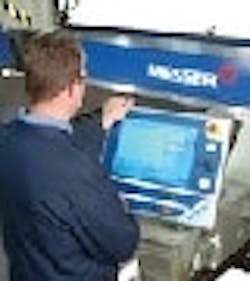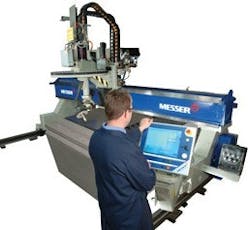Tighter controls lead to cutting remarks
THERE ARE so many ways to cut metal these days that it might as well be paper. Plasma, oxy-fuel, laser, and water-jet technologies each carve steel like leftover turkey. However, all this cutting power can be a proverbial double-edged sword that ironically makes it more difficult for cutting system OEMs to differentiate themselves from their competitors.
For instance, Milwaukee area-based Messer-MG Systems & Welding strives to design its plasma and oxy-fuel cutting machinery well above commodity performance levels for its customers in construction and farm vehicle manufacturing, job shops, steel service centers, and shipbuilding. As a result, Messer bases its identity on robust machinery, open software and controls, and the ability to work seamlessly with other machine tools.
Messer-MG Systems TMC4500ST heavy-duty gantry cutting system with global control uses open standards hardware and software to achieve in-house customization of its HMI.
Early in 2001, Messers U.S., German, and Chinese divisions jointly sought to design a new, standard PC-based control system, and spent a year evaluating control solutions from 24 different suppliers. For its high-end machine designs, Messer decided to use Beckhoffs C6140 industrial PCs with Pentium 2.4 GHz processors running Windows XP Professonal, TwinCat NC PTP and CNC software, and Beckhoffs distributed I/O networked over Lightbus and CP9035 control panels. Messers programmers even learned to write code with the included IEC61131-3-compliant software, so they could create function blocks and structured text.
The open architecture hardware and software lets us pick from several available tools, and quickly configure a machine to match each unique application, says Ringgenberg. As much as wed like to make repeatable product designs, we have to deal with several unique variables every time.
By using fiberoptic cabling and Lightbus I/O, Messer reports it also gained immunity from the radio-frequency (RF) noise that constantly annoyed its systems and staffers in the past. Fiberoptics also reduced network communication delays caused by the copper wires used in the previous system.
Messer reports its plasma-based cutting machines now achieve far shorter cycle times than similar devices, and typically give users 20%+ productivity gains. The company maintains this advantage with its PCs and NC PTP software, which handle point-to-point axis positioning with a positioning algorithm that generates profiles with jerk limitation, as well as speed and acceleration control, to minimize errors. Operating in tandem with its CNC, Messer says the system performs coordinate and kinematic transformations, which enable Messer to handle up to 32 interpolated axes, ≤ 2 ms cycle times, and 100,000 possible I/Os.
Our PC-based controls helped us establish true openness, and our new ability to use different fieldbuses and IEC 61131-3 programming gave us a design freedom we simply didnt have before, explains Ringgenberg. Now, we can reuse our code in a redesigned system if we choose to go that path in the future.
Besides performing control functions on the cutting machines, the CNC software also helped Messer start its HMI design. Were able to use more of our intellectual property than we would otherwise, adds Ringgenberg. Especially important for our HMI, we can do most of the programming and integration ourselves, without relying on third parties who would add their own intellectual properties to the mix. As a result, Messers HMI was written in Microsoft .NET, and also automates many routine functions. For example, an operator can select a part program, and apply optimized cutting parameters from an embedded database.
Generally, our new machine designs have more accurate motion, improved height sensing for our cutting tools, and flexibility for growth, says Ringgenberg. Hardware also is less costly now because integration per machine is reduced, in some cases by 20%.


